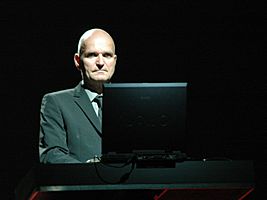Florian Schneider facts for kids
Quick facts for kids
Florian Schneider
|
|
|---|---|

Schneider live in Ferrara, Italy, 2005
|
|
| Background information | |
| Birth name | Florian Schneider-Esleben |
| Born | 7 April 1947 French occupation zone in Germany (now Baden-Württemberg, Germany) |
| Died | 21 April 2020 (aged 73) Düsseldorf, Germany |
| Genres |
|
| Occupation(s) |
|
| Instruments | |
| Years active | 1968–2008, 2014–2015 |
| Associated acts |
|
Florian Schneider-Esleben (born April 7, 1947 – died April 21, 2020) was a German musician. He was famous for being a founder and leader of the electronic band Kraftwerk. He played with the band until 2008.
Contents
Early Life of Florian Schneider
Florian Schneider was born on April 7, 1947. This was in a part of southern Germany controlled by France after World War II. This area later became the state of Baden-Württemberg. His father, Paul Schneider-Esleben, was an architect. His mother was Evamaria. When Florian was three years old, his family moved to Düsseldorf, a city in Germany.
Florian Schneider's Music Career
Florian Schneider started the band Kraftwerk in 1970 with Ralf Hütter. They first met in 1968 while studying at art schools. They played music together in a group called Organisation. Before Kraftwerk, Schneider also played in another group called Pissoff from 1967 to 1968.
Instruments and Sound
When he first started, Schneider mainly played the flute. He used electronic effects to change its sound. These effects included echo, fuzz, and wah-wah. This allowed him to make his flute sound like a bass instrument. He also played the violin, electric guitar, and synthesizers. Later, he even made his own electronic flute. After Kraftwerk's 1974 album, Autobahn, he used fewer traditional instruments.
Schneider once said that he found playing the flute too limiting. He wanted to explore new sounds. So, he started using microphones, speakers, and synthesizers. He eventually stopped playing the flute altogether. He focused on creating unique sounds and using vocoding, which makes voices sound robotic. This special sound became a key part of Kraftwerk's music.
Working with Kraftwerk
Ralf Hütter described Schneider as a "sound perfectionist." This means Schneider wanted every sound to be just right. He believed that with electronic music, you could create music without leaving the studio. He also helped bring the band's studio, Kling Klang, on tour. This allowed them to work on new ideas and computer graphics while traveling.
In 2015, Schneider worked with Dan Lacksman and Uwe Schmidt. They released an electronic song called "Stop Plastic Pollution." This song was made to help protect the oceans from plastic.
Leaving Kraftwerk
Florian Schneider stopped performing with Kraftwerk in 2008. His last show with the band was in November 2006 in Spain. Another person, Stefan Pfaffe, took his place on stage. Stefan was a video technician who worked with the band. News reports confirmed Schneider's departure in January 2009.
Death of Florian Schneider
Florian Schneider passed away from cancer on April 21, 2020. He was 73 years old, and his death came just fourteen days after his birthday.
Florian Schneider's Legacy
Florian Schneider had a lasting impact on music. The famous musician David Bowie even named an instrumental song "V-2 Schneider" after him. Bowie was greatly inspired by Kraftwerk's sound in the late 1970s.
After Schneider's death, the bells of the St. Martin's Cathedral, Utrecht played the tune of Kraftwerk's song "Das Model." This was a special tribute to him.
In 2021, Kraftwerk was chosen to be part of the Rock and Roll Hall of Fame. This shows how important Florian Schneider and the band were to music history.
See also
 In Spanish: Florian Schneider para niños
In Spanish: Florian Schneider para niños

